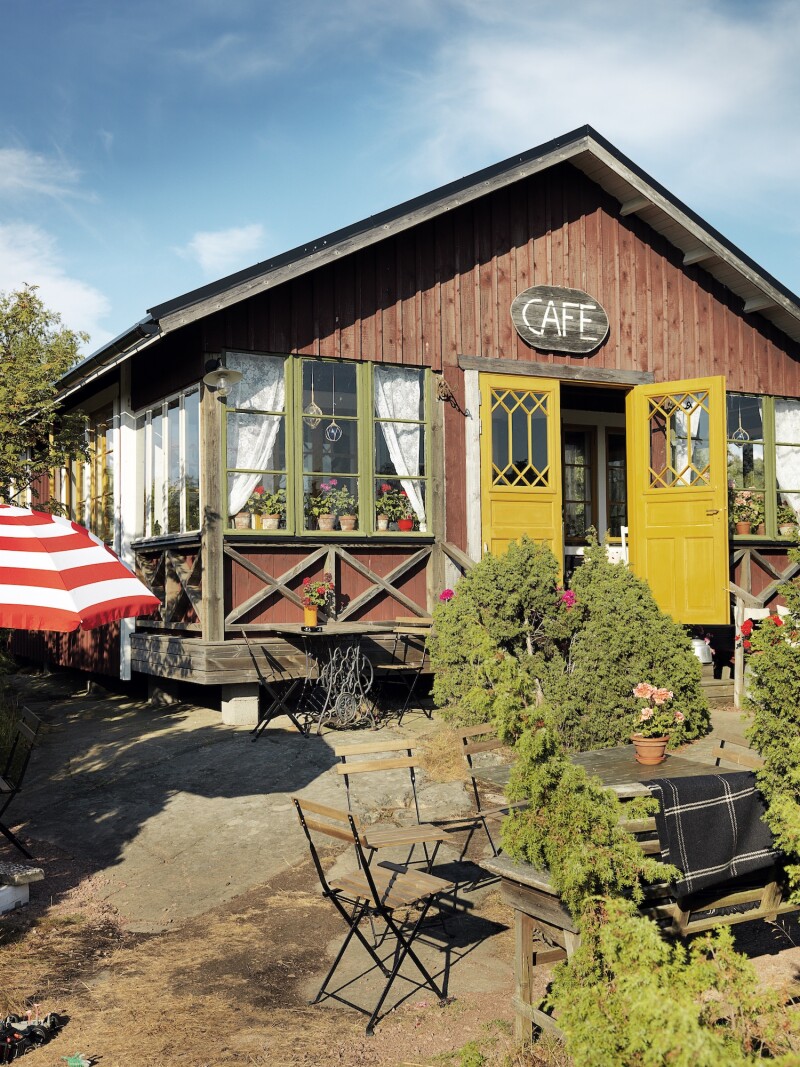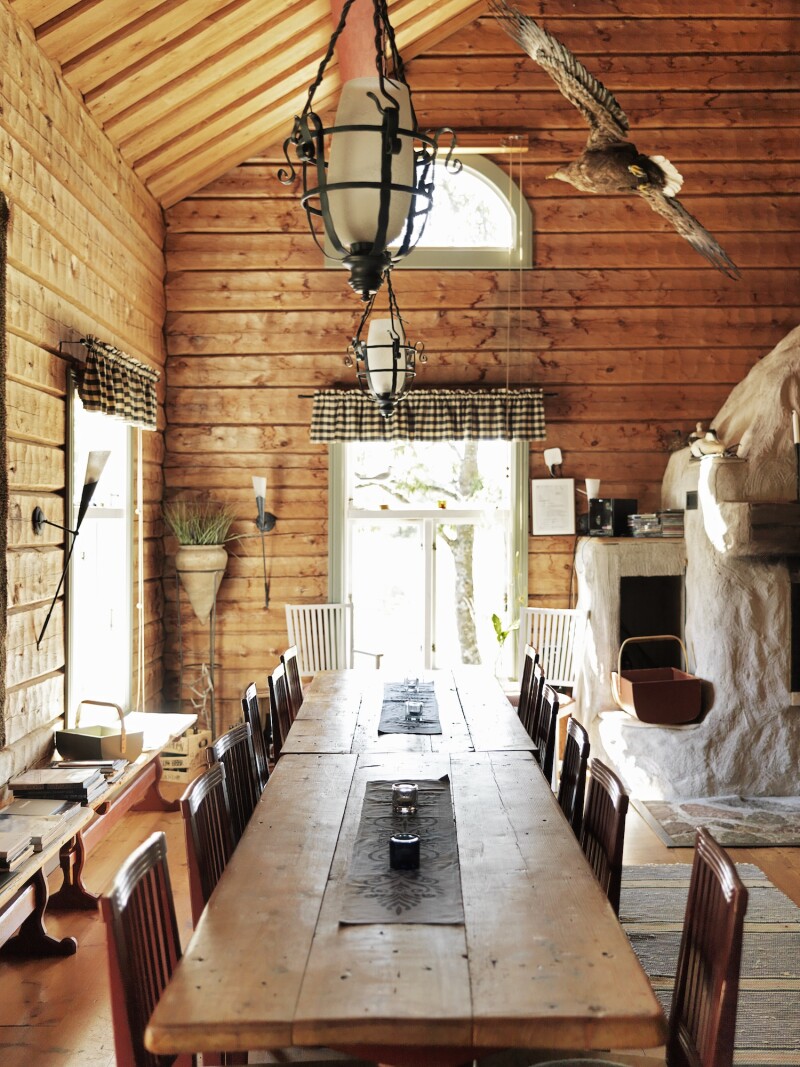When Lotta Jansdotter came across wild raspberries growing in the forest during her childhood summers in Åland—a nature-rich Scandinavian archipelago that seems primed to create magical childhood memories—she didn’t pile them into her cupped hands to carry them home like most kids do. She knew the local trick: pick a long blade of grass or a piece of straw, poke it through the center of the berry, and slide the fruit down to make room for the next, until all the raspberries are lined up like pearls on a string. The method made for easy transport, and prevented the stains and stickiness that usually accompany berry picking. But for Jansdotter it did one thing more. It gave the future graphic designer the idea for what would become one of her signature motifs.
“I seem to have a thing for blobs on sticks,” she says to me, early on in my attempt to experience the peaceful, craft-filled islands through her eyes. An accomplished artist whose prints appear on everything from wallpaper to baby carriers, Jansdotter does frequently feature bulbous forms with long stems in her colorful yet streamlined work: yarrow, dandelion pods, and the variegated sphere of a flowering onion. Maybe that’s because in Åland, where she returns every summer for relaxation and inspiration, there are an uncommon number of blobs on sticks.
Located midway between Finland and Sweden, the Åland archipelago is a semi-autonomous part of Finland, but it holds a population that largely speaks Swedish. Such population as there is, anyway. Only 60 of the archipelago’s 6,700 islands are inhabited, and even on those, people are sparse. Which is, perhaps, why most travelers outside of Scandinavia haven’t heard of it. One evening, I go out for a long bike ride in Mariehamn, the sleepy, broad-streeted capital that sits on the southeastern shore of the main island, and see fewer than a dozen people—and this is in July, the height of tourist season. The few humans are dwarfed by the expanses of sea and forest. Instead, there are wildflowers that pop up between the pines, and moose that are known to swim from island to island, and plenty of crayfish bobbing beneath the gentle waves. Åland is, in other words, every Scandinavian’s dream summer destination.

Photo by Christoph Haidere
For Jansdotter, it’s a reality. With her artfully cropped blond hair, and a sprinkling of stars tattooed across her foot, she looks in step with her adopted Brooklyn, where she has lived for the past eight years with her husband and son. But she was born in Åland, and the islands never got out of her blood. “Although we moved to Stockholm when I was a child, my family returned every summer. When I was a teenager, I was always bored,” she says. “I still return every summer, but now I’m inspired by being here. It’s my antidote to Brooklyn.”
It’s not hard to understand why: Jansdotter’s life in Åland is thoroughly idyllic. Each summer, up to 10 relatives stay in the rambling old house that was once a part of Jansdotter’s great-grandparents’ farm on Vårdö, an island on the eastern side of the archipelago. As a child, she didn’t have many friends nearby, so she passed the long summer days by herself, drawing and daydreaming. “My grandmother saved everything in the attic—wallpaper scraps, magazines, broken plates, fabric,” she recalls. “I used to go up there and just imagine things.”
Now, the days are only slightly more structured. She spends her mornings at work—maybe sketching a flower she came across on a hike, or refinishing a rocking chair she picked up at one of Åland’s many flea markets—before breaking for a swim and a picnic lunch. The family often heads to Vargata, a small village near their house, but sometimes they pile into the boat in search of a new beach. The only requirement is that it be isolated. “My brothers once took me to a beach they had told me was great,” Jansdotter says. “But when we arrived, we found a couple there, swimming. So we left. It was too crowded!”

Photo by Christoph Haidere
Afternoons are for barefoot walks in the woods, or bike rides, or fika (the Swedish term for the beloved coffee break) at such cafés as Johannas Hembakta, where the wallpaper is sweetly floral and the eponymous baker still makes hemvete, the traditional hardtack that once helped Ålanders survive the harsh winters. (She also makes more modern cakes and cookies.) Occasionally, Jansdotter will head into Mariehamn to swing by Kortvaruboden, a shoebox of a shop stocked with the bold Marimekko prints that, as a teen, nurtured her budding interest in textile design, and one of several destinations in Åland for well-made things. Despite the intensely natural vibe—or, maybe because of it—the islands have a small but thriving craft scene, with artists and studios scattered throughout the archipelago.
“That’s an important part of being from here,” Jansdotter says. “You learn to work with your hands. The unofficial Scandinavian motto is: can’t find what you want? Make it. Don’t know how? Then learn!”
One afternoon, Jansdotter takes me to meet her friend Judy Kuitunen, who has just moved her pottery studio from an old dairy in Mariehamn to an old slaughter- house in nearby gölby. With her tomato-red coveralls and a tangle of Shirley Temple blond curls, Kuitunen looks impossibly far removed from her professed 60 years. A trained ceramicist, she moved to Åland from her native Britain 36 years ago and never thought of leaving. “It’s a good place to be an artist,” she says as she leads us around her shop, which features not only her own ceramics—elegant Scandinavian vases and kitschy elk-adorned mugs—but also vintage furnishings and sweets she bakes herself. “There’s a real sense of community. We all support each other’s work.”
I had heard the same thing the day before, when I lost an hour or two at Salt, a collectively owned shop and set of studios in Mariehamn that showcases local artists’ work, from brightly colored woven rugs and silk-screened textiles to delicate silver jewelry and trivets made from thick, knotted rope. I marveled at the level of craftsmanship—and at the variety of approaches. “There’s not really a traditional local style,” said Siv Linney, a potter and one of Salt’s five founders. “In the past, everything had to be fetched in by seamen. But that gave people the freedom to create their own style.”

Photo by Christoph Haidere
There’s also a freedom that comes with living on an island located south of the Arctic circle, where summers mean an average of 18 hours of daylight. Most evenings, Jansdotter heads back to the family home for a sauna, barbecue, and outdoor games that, with the sun still high in the sky, can stretch well into the night. “It’s silly stuff,” she says with a smile. “Races carrying a bucket of sand on your head or throwing pine cones in a bucket. But it’s a great way to socialize without having to talk.”
Spoken like a true Nordic. Like the painted wooden houses and festooned maypoles left over from the Midsummer celebrations held each June, Åland’s quiet is a constant reminder that although the archipelago may have ice cream stands and mini golf courses in common with the vacation destinations of the world, it is still a profoundly Scandinavian place. People drink a lot of coffee. You can get anywhere by bike. And nature, including the chanterelles in the forest and the perch in the sea, is considered common property, as long as it’s treated with respect. Like other Nordic regions, Åland practices Everyman’s Right, which guarantees the right of anyone to walk, ski, boat, swim, forage, and fish in any natural area.
Jansdotter makes use of every provision, though she still hasn’t acquired the Ålander trick of smoking the fish she catches—that’s next on her growing list. She wants to plant deeper roots, which is why she drives around Åland in a car packed with flea market furniture. Only natives or longtime residents can easily buy property here, and last year Jansdotter exercised her right. She and her husband acquired land on Vårdö, near her family home, and have plans to build their own house. But they haven’t started yet, so she has no place to put her purchases. That, like the fish smoking and net laying and boat navigation that she hopes to one day learn, will have to wait for the right moment. On Åland, it’s never far off.

Photo by Christoph Haidere











